| |
|
|
God is always on the side of the big
battalions.
|
|
Attributed to Henri de la Tour d"Auvergne,
Viscomte de Turenne (1611-1675)
|
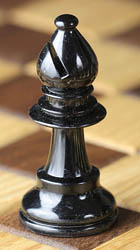  Since
God condoned and encouraged war, and participated in it himself,
it was natural that his Churches should do the same. For many
centuries the clergy played an active part in war, a fact of
which we are reminded by the chess piece known in English as
a bishop. Junior clergy, bishops, archbishops, cardinals, popes
and patriarchs all took an active part in warfare. Since
God condoned and encouraged war, and participated in it himself,
it was natural that his Churches should do the same. For many
centuries the clergy played an active part in war, a fact of
which we are reminded by the chess piece known in English as
a bishop. Junior clergy, bishops, archbishops, cardinals, popes
and patriarchs all took an active part in warfare.
Until the Middle Ages Christians waged war mainly to convert
by force the people they considered heathens. During the Middle
Ages they concentrated on Muslims, with a few European excursions
to slaughter Jews, dissident Christians and political enemies
of the Church. By the fifteenth century the Church was powerful
enough to become more ambitious. Pope Nicholas V, in his bull
Romanus Pontifex (1452) declared war on all non-Christians
throughout the world, not merely sanctioning but actively promoting
conquest, colonisation and exploitation of non-Christians peoples
and their lands.
  Countless
clergymen had been crusaders. Senior clerics led armies into
battle with varying degrees of success. Pope Leo IX led his
army against marauding forces in southern Italy in 1053 but
fared badly. Pope Julius II, on the other hand, was acknowledged
to be a better soldier than a theologian. A keen military strategist,
he had no qualms about donning armour and fighting on behalf
of God and the Papal States. Known as Il Terribile
he led a number of victories in the Italian wars of the early
sixteenth century. He sent Christopher Bainbridge, Archbishop
of York, to lead a military expedition against Ferrara in 1511. Countless
clergymen had been crusaders. Senior clerics led armies into
battle with varying degrees of success. Pope Leo IX led his
army against marauding forces in southern Italy in 1053 but
fared badly. Pope Julius II, on the other hand, was acknowledged
to be a better soldier than a theologian. A keen military strategist,
he had no qualms about donning armour and fighting on behalf
of God and the Papal States. Known as Il Terribile
he led a number of victories in the Italian wars of the early
sixteenth century. He sent Christopher Bainbridge, Archbishop
of York, to lead a military expedition against Ferrara in 1511.
Because the Church maintained that it should not be responsible
for shedding blood, clerical warriors favoured weapons that
battered rather than pierced flesh. Thus, for centuries the
mace was the favourite ecclesiastical mode of killing in battle.
Apart from this small qualm, churchmen had no doubts about the
propriety of killing.
|
Head of a War Mace, traditionally identified
as the favoured weapon of medieval Ecclesiastical warriers.
(in fact ecclesiastics seem to have used the same range
of weapons as other knights)
|
|
|
Senior clerics would ride up and down the battle lines before
the fighting started, wearing their ecclesiastical robes, often
holding holy relics, giving blessing and absolution.
When the Anglican Church was established, the 37 th of the
39 Articles expressly stated that it is lawful for Christian
men to wear weapons and serve in wars.
|
Pope Julius II (centre, wearing his papal
tiara and armour)
exhorting European rulers to join him in a war against
Venice
(You can make out the Kings of Castile, England and France,
and the Holy Roman Emperor)
|
|
|
Some clerics are remembered mainly for their war records. Robert
of Geneva, a cardinal and papal legate, was one. He is most
notable for his part in the papacy's battle against Florence.
At Cesena in 1377 he persuaded the locals to lay down their
arms with promises of mercy. When they did he sent in his mercenaries
to kill them — 8,000 men, women and children. This was
not untypical. Thousands of Waldensianss in Calabria were massacred
by Roman Catholic troops in 1560 under Grand Inquisitor Michele
Ghislieri, later Pope Pius V, and now a saint.
|
For many cnturies Christians were taught
that God and his heavenly helpers gave great Christian
leaders magical swords to help them. A sword called Durandal
was supposedly given to Charlemagne by an angel. It contained
a tooth of Saint Peter, the blood of Saint Basil, some
hair from Saint Denis, and a piece of clothing of the
Blessed Virgin Mary. It was supposedly the sharpest sword
in all existence. In the Song of Roland, the sword
is given to Roland and he uses it to defend himself against
thousands of Muslim attackers.
(Illustration shows Roland receiving Durandal from Charlemagne)
|
|
|
  A
"blessed sword" (ensis benedictus) and a "blessed
hat" were together given by popes to Catholic leaders for
making war on behalf of the pope. Each gift was blessed by the
reigning pope on Christmas Eve in St. Peter's Basilica in Rome.
The sword was up to 2 metres long, with the hilt embellished
with the pope's coat of arms, and the blade engraved with the
pope's name. The hat was a cylinder made of red velvet with
two lappets hanging down (like those on a bishop's mitre). The
pope sprinkled the sword and hat with holy water and incensed
them three times. The recipient was dressed in a suplice, like
a cleric, and the pope asked him to kill the pope's enemies:
"Therefore, may your hand remain firm against the enemies
of the Holy See and of the name of Christ, and may your right
hand be lifted up, intrepid warrior, as you remove them from
the earth ..." A
"blessed sword" (ensis benedictus) and a "blessed
hat" were together given by popes to Catholic leaders for
making war on behalf of the pope. Each gift was blessed by the
reigning pope on Christmas Eve in St. Peter's Basilica in Rome.
The sword was up to 2 metres long, with the hilt embellished
with the pope's coat of arms, and the blade engraved with the
pope's name. The hat was a cylinder made of red velvet with
two lappets hanging down (like those on a bishop's mitre). The
pope sprinkled the sword and hat with holy water and incensed
them three times. The recipient was dressed in a suplice, like
a cleric, and the pope asked him to kill the pope's enemies:
"Therefore, may your hand remain firm against the enemies
of the Holy See and of the name of Christ, and may your right
hand be lifted up, intrepid warrior, as you remove them from
the earth ..."
Not all recipients are known; among those whose names have
been preserved, are twelve emperors of the Holy Roman Empire,
ten kings of France, seven kings of Poland, and six kings of
Spain. Additionally, three or four blessed swords and hats were
given to kings of England, two or three to kings of Scots, and
three each to the kings of Hungary and Portugal. Recipients
also included various princes, including heirs-apparent, archdukes,
dukes, noblemen, military commanders, as well as cities and
states
|
Pope Alexander III hands a holy sword
to the Venician Doge Sebastiano Ziani,
Doge of Venice from 1172 to 1178. (The papal side had
been victorious over Holy Roman Emperor Frederic Barbarossa
at the Battle of Legnano 1176)
Pope Alexander III Receiving and Blessing Doge Sebastiano
Ziani (oil on panel),
painting by Bassano, Francesco (Francesco da Ponte) (1549-92)
|
|
|
Prisoners of war could not expect mercy and were frequently
tortured or murdered. As a boy of eight, Erasmus had witnessed
200 prisoners broken on the wheel outside the gates of Utrecht
on the orders of the city's bishop. Again, this was far from
exceptional. The sixteenth and seventeenth centuries were characterised
by numerous religious wars in Europe. With a single respite,
such wars were endemic from the 1520s until 1648.
|
Henry Beaufort, better known as Cardinal
Beaufort, was a fifteenth century Cardinal Bishop of Winchester.
He exemplified several characteristics of the Church in
the late Middle Ages. He fathered an illegitimate daughter,
Jane Beaufort, in 1402. As Bishop of Winchester, he drew
revenues from licensing prostitutes (known as Winchester
Geese). A member of the royal house of Plantagenet, he
was elevated to Cardinal in 1426. As Papal Legate for
Germany, Hungary, and Bohemia, he personally led an army
against the Hussites, which were routed at Tachov on 4
August 1427. His other notable contribution to human history
was to preside over the trial of Joan of arc, another
divinely inspired warrier.
Joan of arc interrogated in her prison
cell by Cardinal Winchester [Henry Beaufort].
By Hippolyte (Paul) Delaroche, 1824, Musée des
Beaux-Arts, Rouen, France.
|
|
|
Zwingly, the famous reformer, died in the Battle of Kappel
in 1531, trying to force Roman Catholic cantons of Switzerland
to become Protestant ones. Some wars, such as the Bishops"
Wars, which started in 1639, boast ecclesiastical titles
reflecting the issue being disputed, in this case the validity
of the episcopacy. European nations divided on sectarian lines
on every conceivable issue. The
Thirty Years" War was typical. In 1618 the Habsburg Emperor
Ferdinand II decided to eradicate Protestantism in Bohemia.
His Roman Catholic army fought and routed a Protestant one,
and started to extirpate the Protestant population. The King
of Denmark, Christian IV, sent another Protestant army, which
was joined by German Lutherans and Calvinists. It too was defeated
and the massacres resumed. Now the King of Sweden, Gustavus
Adolphus, led yet another Protestant army into battle. It enjoyed
great success until Gustavus was killed. On both sides the slaughter
continued at a rate that Europe had never seen before. Eventually,
for political reasons, France joined in on the side of the Protestants,
although France was still persecuting its own Protestant population.
After 30 years of fighting, a settlement was concluded in 1648
at the Peace of Westphalia. The population was so reduced that
there were not enough people left to rebuild the towns, resume
trade, or even plant the fields. Estimates of the numbers killed
vary from a tenth to over half of the population. The truth
lies somewhere between the two, but whatever the exact proportion
it is certain that millions died and millions were orphaned
by Christian forces in the name of God.
|
Prince-Bishop Franz Von Waldeck
wearing his armour and his bishop's mitre
carrying a sword as well as a crozier.
|
|
|
The coats of arms of many old bishoprics still feature various
types of military weapon - A number of Anglican bishops have
swords in their coats of arms reflecting their temporal power.
|
Arms of the
Bishop of London
|
Arms of the
Bishop of St-Albans
|
Arms of the
Bishop of Winchester
|
Arms of the
Bishop of Exeter
|
|
|
|
|
|
Churches were always ready to affirm God's support for causes,
however disreputable they might now appear. The clearances of
the Scottish highlands in the eighteenth century were assisted
by churchmen. Scottish ministers threatened their flocks with
eternal hellfire if they did not follow instructions to abandon
their homes to make way for sheep.
|
Klemens August of Bavaria 1700-1751,
Bishop of Cologne
still wearing armour in the eighteenth century
|
|
|
On the other side of the Atlantic, the extirpation of entire
tribes of Native Americans was hailed as the will of God. In
the Far East, God was seen to be behind the First Opium war
of 1839-42. He may or may not have cared about opening up the
opium trade within China, but missionaries were certain that
he wanted them to have access to the country, and he had done
this by giving victory to the Christian forces. Some wars have
been prolonged unnecessarily by Christian Churches. For example
Southern clergymen prolonged the American Civil War long after
the Confederates had any hope of winning. Clergymen simply could
not accept that God could let them lose. God's unfulfilled promises
delivered through the Southern Churches contributed significantly
to the approximately 600,000 killed and one million injured.
Killing rates had by then been increased by an invention of
a clergymen following in the ancient Christian tradition of
clerical military engineers. The percussion cap was patented
by the Rev. A. J. Forsyth of Belhelvie, Aberdeenshire, Scotland
in 1807. Forsyth was principally interested in killing animals.
He had noticed that sitting birds would startle when smoke from
the powder pan of his flintlock shotgun give them warning of
the shot. His invention of a new firing mechanism deprived the
birds of their early warning so made it easier to kill them.
|
The Puckle gun (or Defence gun) was a
crew-served, manually-operated flintlock revolver patented
in 1718 by James Puckle, a British inventor, lawyer and
writer. It was one of the earliest guns to be referred
to as a "machine gun". Puckle developed two
configurations of the design: one fired conventional round
bullets and was intended for use by Protestants against
Catholics. The second fired square bullets and was intended
for use by Christians against Muslims (square bullets
were thought to cause more physical damage than round
ones). They would, according to Puckle's patent, "convince
the Turks of the benefits of Christian civilization".
(Source: James Puckle's 1718 patent, number 418.)
The diagram below is an advertisement for the Puckle Gun.
|
 |
The last senior churchman to take part in war was Leonidas
Polk, Bishop of Louisiana, who enlisted in the Confederate army
with rank of Major General during the American Civil War. More
junior clergy continued to fight for longer, even when they
were technically prohibited from doing so, into the twentieth
century. Despite the provisions of canon law, Christian priests
and ministers enlisted in order to fight in World War I. Almost
80,000 priests enlisted from the Roman Catholic Church alone.
When the USA joined in the war on the side of the allies, American
priests and ministers affirmed that the Kaiser was not a Christian,
that his empire was blasphemous, that the war was a holy war,
that God had summoned the American people to join it, that the
German people deserved to be exterminated, that Jesus himself
would have joined the American army, and that conscientious
objectors could not be true Christians*.
In Europe, clergymen preached in support of the war, and those
who chose not to enlist were sent white feathers by their righteous
Christian neighbours just as, centuries before, those who failed
to enlist for the Crusades had been sent distaffs or knitting
needles. Despite what American clergymen said about the Kaiser,
the three European emperors involved in World War I were all
devout Christians. So were their most hawkish senior ministers.
Bishops confirmed the righteousness of their respective causes.
The Right Reveverend Francis Chavasse, Bishop of Liverpool,
told British conscientious objectors on 26 May 1916 that they
should leave the country if they refused to fight. The only
opposition to that war came from Secular freethinkers, Quakers
and a few eccentric fringe Christian groups. Atheists like Bertrand
Russell were imprisoned for campaigning for peace and suffered
in other ways (Russell for example was deprived of his lectureship
at Trinity College, Cambridge).
In more recent wars the Churches have maintained their records.
The majority of mainstream Churches in World War II informed
their followers that God was on their side (even when members
of the same denomination fought on opposite sides). In Germany
all the main denominations collaborated with the Nazi war effort:
Roman Catholic, Protestant and nonconformist alike. Nazi atrocities
were carried out almost entirely by Christians — roughly
two-thirds Protestant, one third Roman Catholic. Only Jehovah's
Witnesses denounced Nazism as totally evil, refused conscription,
and took the consequences. By contrast, in the whole of the
Third Reich, only seven Roman Catholics refused conscription*.
|
|
|
Papal States contract Remington Model
1868 Pontifico Rolling Block rifle with bayonnet.
Presented by the Pope to the Dutch politician Petrus Regout,
mid 19th century
|
|
|
Since World War II, Christians have continued to fight and
kill each other. Christian factions in the Lebanon killed not
only Muslims but also members of rival Christian factions. In
the Balkans, Eastern Orthodox Christians and Roman Catholic
Christians have been killing each other for centuries. An American
cardinal (Spellman) could be relied on to confirm that the USA's
war against Vietnam was a war in support of the Christian faith.
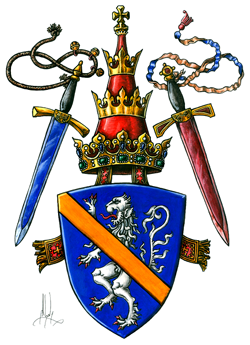 The
fighting between Orthodox Serbs and Roman Catholic Croats in
former Yugoslavia during the 1990s was only a coda to similar
atrocities in the past. The sectarian violence that has persisted
in Northern Ireland since 1968 is another coda, this time to
the religious wars conducted throughout Europe in the fifteenth
and sixteenth centuries. In all there have been thousands of
murders since the troubles started in Northern Ireland. Sometimes
the murders are carried out in churches. Claims that these murders
are purely political are undermined by the fact that no one
except the devout are involved. All of the murderers caught
have been staunch Roman Catholics or staunch Protestants, as
are all of the spokesmen for the two sides. In other parts of
the world, where the public spotlight is dim, one Church or
another is likely to sanction sectarian killing, and sometimes
to join in. Roman Catholics, including many priests and nuns,
were for example implicated in the widespread massacres in Rwanda
in 1994*. As one Nairobi
based journalist comments: The
fighting between Orthodox Serbs and Roman Catholic Croats in
former Yugoslavia during the 1990s was only a coda to similar
atrocities in the past. The sectarian violence that has persisted
in Northern Ireland since 1968 is another coda, this time to
the religious wars conducted throughout Europe in the fifteenth
and sixteenth centuries. In all there have been thousands of
murders since the troubles started in Northern Ireland. Sometimes
the murders are carried out in churches. Claims that these murders
are purely political are undermined by the fact that no one
except the devout are involved. All of the murderers caught
have been staunch Roman Catholics or staunch Protestants, as
are all of the spokesmen for the two sides. In other parts of
the world, where the public spotlight is dim, one Church or
another is likely to sanction sectarian killing, and sometimes
to join in. Roman Catholics, including many priests and nuns,
were for example implicated in the widespread massacres in Rwanda
in 1994*. As one Nairobi
based journalist comments:
When I think of the Vatican's record in Africa, I think of
its failure to acknowledge what really happened in Rwanda,
where priests and nuns not only led death squads to Tutsi
refugees cowering in their churches, but provided the petrol
to burn them alive, took part in the shootings and raped survivors.
Rwanda was Africa's most devout Catholic nation, and the role
the church played in condoning and fostering the Hutu extremism
that climaxed in genocide is as shameful as its collaboration
with the Nazis.*
Belgian priests have been implicated in encouraging killings
for generations. Father Guy Theunis, of the Roman Catholic Order
of the White Fathers, was just the most recent Belgian to be
charged with crimes against humanity for his role in encouraging
the 1994 Rwandan genocide*.
Rwandan priests and nuns were convicted for their parts in the
massacres.
.jpg)  All
of the main Churches have a poor record with respect to warfare.
All have supported their own wars and massacres, and all have
lent support to national wars. The injured were generally left
to die, either of their wounds, or at the hands of their captors.
Few Christians thought of aiding the wounded or of protecting
non-combatants. After all, wars and suffering were ordained
by God. In the nineteenth century people outside the Christian
mainstream made the first significant efforts to prevent wars
or minimise related suffering. Henri Dunant (1828-1910), a Swiss
freethinker and anticlerical philanthropist, was responsible
for founding the International Committee of the Red Cross and
for the Geneva Convention held in 1864. Dunant's inspiration
was the suffering he had seen on the battlefield at Solferino
in 1859. Christians had been accustomed to such sights for centuries,
but few had done anything practical about it, and none had done
anything as significant as Dunant. Indeed it not easy to think
of any mainstream Christian who made a contribution as significant
as the Muslim leader, Saladin, 700 years earlier. All
of the main Churches have a poor record with respect to warfare.
All have supported their own wars and massacres, and all have
lent support to national wars. The injured were generally left
to die, either of their wounds, or at the hands of their captors.
Few Christians thought of aiding the wounded or of protecting
non-combatants. After all, wars and suffering were ordained
by God. In the nineteenth century people outside the Christian
mainstream made the first significant efforts to prevent wars
or minimise related suffering. Henri Dunant (1828-1910), a Swiss
freethinker and anticlerical philanthropist, was responsible
for founding the International Committee of the Red Cross and
for the Geneva Convention held in 1864. Dunant's inspiration
was the suffering he had seen on the battlefield at Solferino
in 1859. Christians had been accustomed to such sights for centuries,
but few had done anything practical about it, and none had done
anything as significant as Dunant. Indeed it not easy to think
of any mainstream Christian who made a contribution as significant
as the Muslim leader, Saladin, 700 years earlier.
|
Contemporary medieval records leave no
doubt that churchmen took an active part in war, but the
Churches have been remarkably effective in effacing any
suggestion of the fact from modern popular culture. In
France, even the bishops on the chess board have become
"fools". Warrior bishops rarely feature in novels,
plays or films. They are very slowly re-emerging in historical
re-enactment groups, as shown below.
|
|
|
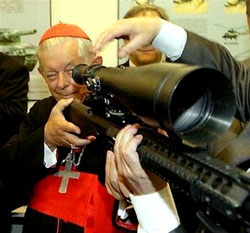  Conscientious
objection to war is another phenomenon from outside mainstream
Christianity. St Augustine had said that war could be waged
if it was waged by the command of God. Christians had interpreted
this as a right to wage war on behalf of God. Soon the right
became a duty. Thus it was positively sinful not to
participate in a war on God's behalf. So it was that that the
concept of conscientious objection to war could not be tolerated.
It amounted to setting one's own conscience above that of God.
This was still the prevailing orthodoxy at the beginning of
the twentieth century. Before World War I the National Secular
Society and other freethinking individuals opposed compulsory
military training in secondary schools. During the war they
fought for the rights of conscientious objectors. For such positions
they were roundly condemned by the mainstream Churches. The
only significant support from any religious group came from
the Quakers. The idea of creating a world where war would be
impossible was another non-Christian ambition. It might have
been idealist, but at least it led to some action. Atheists
like H. G. Wells and Gilbert Murray worked for a world parliament
as a way to reduce or eliminate war. Their efforts culminated
in the League of Nations (1919) and its successort, the United
Nations (1945). Conscientious
objection to war is another phenomenon from outside mainstream
Christianity. St Augustine had said that war could be waged
if it was waged by the command of God. Christians had interpreted
this as a right to wage war on behalf of God. Soon the right
became a duty. Thus it was positively sinful not to
participate in a war on God's behalf. So it was that that the
concept of conscientious objection to war could not be tolerated.
It amounted to setting one's own conscience above that of God.
This was still the prevailing orthodoxy at the beginning of
the twentieth century. Before World War I the National Secular
Society and other freethinking individuals opposed compulsory
military training in secondary schools. During the war they
fought for the rights of conscientious objectors. For such positions
they were roundly condemned by the mainstream Churches. The
only significant support from any religious group came from
the Quakers. The idea of creating a world where war would be
impossible was another non-Christian ambition. It might have
been idealist, but at least it led to some action. Atheists
like H. G. Wells and Gilbert Murray worked for a world parliament
as a way to reduce or eliminate war. Their efforts culminated
in the League of Nations (1919) and its successort, the United
Nations (1945).
|
A Russian Orthodox priest blesses weapons
(circa 1994)
for soldiers before they are sent off to Chechnya to kill
Muslims.
|
|
|
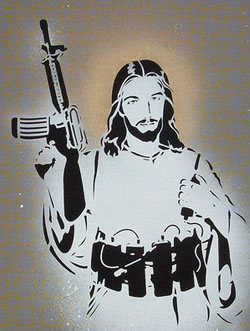  For
many non-Christians the idea that any god might condone or participate
in any war is absurd. The emerging mainstream Christian view
of war concurs. A few small heretical sects have also held this
view consistently from early times. The Quakers have held this
view since their founding in the seventeenth century and the
Jehovah's Witnesses since their founding in the nineteenth century,
but for all other Christians it is novel, and has been adopted
only since it became the prevailing secular view. Not all Christians
have yet decamped and joined the secular ranks. In the second
half of the twentieth century a number of studies have been
carried out into attitudes towards war, especially in the USA.
What they reveal is fairly consistent. Roman Catholics and Protestants
are more accepting of war than average, while atheists are not
only less accepting of it, but also more likely to be actively
opposed to it*. Religious
wars — crudades as much as Jihads — are particularly
repellent to non-believers. For
many non-Christians the idea that any god might condone or participate
in any war is absurd. The emerging mainstream Christian view
of war concurs. A few small heretical sects have also held this
view consistently from early times. The Quakers have held this
view since their founding in the seventeenth century and the
Jehovah's Witnesses since their founding in the nineteenth century,
but for all other Christians it is novel, and has been adopted
only since it became the prevailing secular view. Not all Christians
have yet decamped and joined the secular ranks. In the second
half of the twentieth century a number of studies have been
carried out into attitudes towards war, especially in the USA.
What they reveal is fairly consistent. Roman Catholics and Protestants
are more accepting of war than average, while atheists are not
only less accepting of it, but also more likely to be actively
opposed to it*. Religious
wars — crudades as much as Jihads — are particularly
repellent to non-believers.
|
Only after a secular pubic outcry in
2010 did the Pentagon stop buying gun sights stamped with
New Testament referrences to use against Moslems in Iraq
and Afghanistan*.
|
|
|
  The
whole Christian movement remains full of military allusions:
Church Militant, Soldiers of Christ, Salvation
Army, Church Lad's Brigade, Crusade,
Lord's Resistance Army, etc. Christian Churches continue
to explicitly “wage war” on unbelievers. Anyone
one who voices public criticism of Christianity can expect to
receive communications from devout Christian foot soldiers assuring
them that they will burn in hell for all eternity, and threatening
personally to accelerate the entry process. No Church ever seems
to do anything to stop their foot soldiers making such death
threats, and why should they? After all Jesus himself promised
imminent and everlasting hell-fire to unbelievers. The
whole Christian movement remains full of military allusions:
Church Militant, Soldiers of Christ, Salvation
Army, Church Lad's Brigade, Crusade,
Lord's Resistance Army, etc. Christian Churches continue
to explicitly “wage war” on unbelievers. Anyone
one who voices public criticism of Christianity can expect to
receive communications from devout Christian foot soldiers assuring
them that they will burn in hell for all eternity, and threatening
personally to accelerate the entry process. No Church ever seems
to do anything to stop their foot soldiers making such death
threats, and why should they? After all Jesus himself promised
imminent and everlasting hell-fire to unbelievers.
| |
  |
|
St. Mercurius killing Roman emperor Julianus,
Church of St. Mercurius, Old Cairo
|
|
|
| |
|
St Barbara, patron saint of gunners,
depicted on a cannon
|
|
|
| |
|
Miniature of Edmund Crouchback with St.
George; English illumination by ‘The Workshop of
the Walter de Milemete treatises’, in a Book of Hours.
Eraly 14th century; after 1322
|
|
|
| |
|
Manuscript BNF Nouvelle acquisition française
15941 Miroir Historial (Vol 3), Folio 2r, 1370-1380, Paris,
France, Bibliothèque Nationale
|
|
|
| |
| |
|
|
| |
| Gustave-Dore-The_Destruction_Of_Armies_Of_Ammonites_Moabites
- Ch2 20, 22-3.jpg |
 |
| |
|
Albrecht Durer, St. George
|
|
|
| |
|
United States Army Special Forces
|
|
|
| |
|
The Last Crusader by K.
F. Lessing
|
|
|
| |
|
The Dedication by Edmund Blair Leighton,
1908.
|
|
|
| |
|
The Crusaders Massacre the Inhabitants
of Ceasarea - Gustave Dore
|
|
|
| |
|
Saul slays Ahimelech and his priests
|
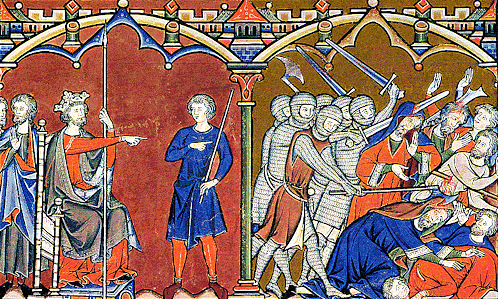 |
| |
|
St. Gallen, Stiftsbibliothek, Ms. Vad.
302 II, fol. 35v, 13th century manuscript
|
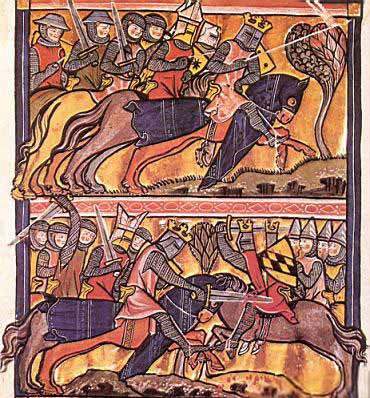 |
| |
|
Thomas Cecill, Elizabeth I receiving
a lance from Truth and defeating the Catholic dragon,
ca. 1625.
|
 |
| |
|
The Angels of Mons - A First World War
fiction that was later "verified" by eye witnesses.
|
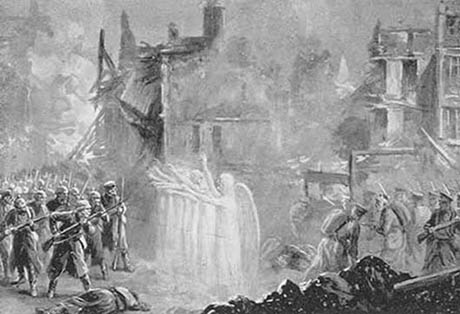 |
| |
|
The Angels of Mons - A First World War
fiction that was later "verified" by eye witnesses.
|
 |
| |
|
The Angels of Mons - A First World War
fiction that was later "verified" by eye witnesses.
|
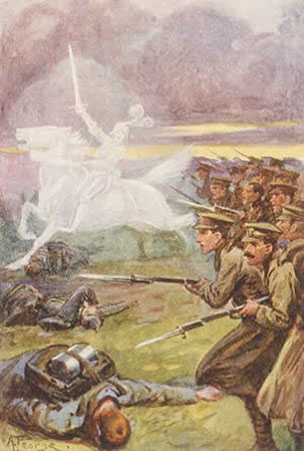 |
| |
|
Polish priest blessing wz. 36 grenade
launchers, Kraków, 1936
|
 |
| |
|
French soldiers gather around a priest
as he blesses an aircraft on the Western Front, 1915.
|
 |
| |
| |
|
Romanian Priest Blesses Romanian soldiers
|
|
|
| |
|
Part of the Miseries of War series of
engravings by Jacques Callot (1592–1635), c. 1633.
|
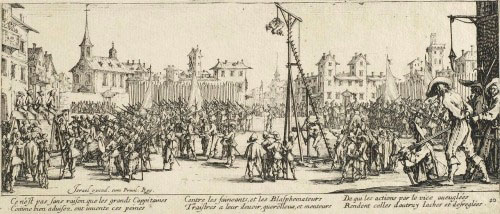 |
| |
|
Morgan M.638 Maciejowski Bible f32
|
|
|
| |
| |
|
|
| |
| |
|
|
| |
| |
|
|
| |
|
A World War I propaganda cartoon depicting
the Kaiser kissing the devil.
(The Kaiser standing on tip-toes is loaded with impications)
|
|
|
| |
| |
|
|
| |
|
For God, Kaiser and Fatherland!
|
|
|
| |
| |
|
|
| |
| |
|
Chester, A patriotic song popular during
the American Revolution.
|
Let tyrants shake their iron rod,
And Slav'ry clank her galling chains,
We fear them not, we trust
in God,
New England's God forever reigns.
Howe and Burgoyne and Clinton too,
With Prescot and Cornwallis join'd,
Together plot our Overthrow,
In one Infernal league combin'd.
When God inspir'd us for the
fight,
Their ranks were broke, their lines were forc'd,
Their ships were Shatter'd in our sight,
Or swiftly driven from our Coast.
The Foe comes on with haughty Stride;
Our troops advance with martial noise,
Their Vet'rans flee before our Youth,
And Gen'rals yield to beardless Boys.
What grateful Off'ring shall we bring?
What shall we render to the Lord?
Loud Halleluiahs let us Sing,
And praise his name on ev'ry Chord.
|
| |
| |
The Great and Holy War
How World War I Became a Religious Crusade
By Philip Jenkins
Philip Jenkins, the author of The Lost History of Christianity,
Jesus Wars, and The Next Christendom, is the Distinguished
Professor of History and a member of the Institute for
Studies of Religion at Baylor University
The war was fought by the world's leading Christian nations,
who presented the conflict as a holy war. Thanks to the
emergence of modern media, a steady stream of patriotic
and militaristic rhetoric was given to an unprecedented
audience, using language that spoke of holy war and crusade,
of apocalypse and Armageddon. But this rhetoric was not
mere state propaganda. Jenkins reveals how the widespread
belief in angels and apparitions, visions and the supernatural
was a driving force throughout the war and shaped all
three of the major religions - Christianity, Judaism and
Islam - paving the way for modern views of religion and
violence. The disappointed hopes and moral compromises
that followed the war also shaped the political climate
of the rest of the century, giving rise to such phenomena
as Nazism, totalitarianism, and communism.
Holy war rhetoric was not new to World War I, having
been used to rousing effect during the Crusades. As Jenkins
(History and Religious Studies/Baylor Univ.; Laying Down
the Sword: Why We Can't Ignore the Bible's Violent Verses,
2011, etc.) delineates, the "highly material conflict"
of 1914 and the messianic zeal undertaken by Germany and
Russia especially rendered this a uniquely disastrous
and foreboding phenomenon. Not only did the powerful states
of the czar and kaiser glorify in the language of divine
providence in justifying their aggression, but the church
leaders in the West also employed violent language involving
Christian duty and honor to save Christian civilization
from "God's enemies," the barbaric Germans.
World War I erupted during a time when religious themes
still resonated powerfully with rural and peasant societies,
and medieval imagery of battling knights and angels was
used frequently in propaganda. For Protestant Germany,
the war heralded God's special mission for the nation.
Yet rumors of German atrocities unleashed tales of Christ-like
suffering. Spiritual calls to sacrifice and martyrdom
underpinned the militarism and nationalism of the embroiled
nations, and as the grisly slaughter grew, shocking people
with the numbers of dead-the French lost 27,000 men on
Aug. 22, 1914, alone at the Battle of the Frontiers-so
did the use of the language of the apocalypse. Superstition
among soldiers was common, as were sightings of angels
and the walking dead on the battlefields. While the war
was largely a Christian struggle, the Ottoman Empire jumped
in with stirring calls to sacrifice one's life "for
the safety of the faith." Indeed, as Jenkins carefully
portrays, the war changed everything, from the collapse
of the old order to the compromising and weakening of
world faiths.
|
|
|
|
Modern reenactment of Medieval warfare
|
 |
More Christian Violence and Warfare
|
|
|
|
|
|
|
|
|
|
|
|
|
|
|
|
|
|
|
|
|
|
|
|
|
|
|
|
|
|
|
|
|
|
|
|
|
|
Buy the Book from Amazon.com
|
|
|
|
|
|
Buy the Book from Amazon.co.uk
|
|
|
| |
| |
| More Books |
|
|
|